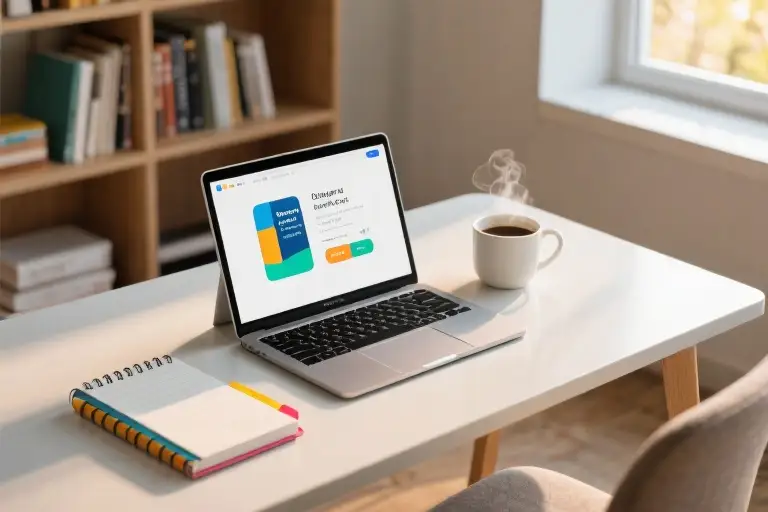The conference room air conditioning hummed too loudly as my student – a senior tech executive – wiped his palms on his trousers. His PowerPoint slide displayed a quantum computing diagram, but his words came in staccato bursts: ‘This…the q-bit…how to say…like traditional computer but…’ His fingers twisted in the air as if physically shaping the elusive terminology.
I recognized that particular flavor of frustration. The kind where a highly articulate professional suddenly regresses to childlike speech patterns when crossing language barriers. My standard teaching playbook – the one filled with restaurant role-plays and weather vocabulary – lay useless in my lap.
What we were missing became glaringly obvious in that moment. Adult learners don’t need linguistic training wheels. They need bridges between their existing expertise and new language tools. That forty-five-year-old CFO shouldn’t be describing cartoon characters when he’s capable of discussing blockchain applications – if only we could unlock that vocabulary.
The disconnect goes deeper than word gaps. Traditional ESL materials assume learners progress from ‘This is a pen’ to ‘My hobby is gardening’ before tackling specialized topics. But adult professionals live in the opposite reality. They’ll attend board meetings discussing quarterly forecasts before mastering past continuous tense. Their learning journey isn’t linear – it’s a series of urgent linguistic firefights.
This creates a peculiar classroom dynamic. The same executive who negotiates million-dollar contracts may freeze when asked ‘How was your weekend?’ Not because of complexity, but because the question feels irrelevant to their actual communication needs. We’ve all seen that glazed look when students mentally check out during yet another ‘shopping dialogue’ exercise.
So here’s the uncomfortable question we must confront: When our meticulously planned lessons consistently crash against the rocks of real-world communication needs, what exactly are we teaching for? The answer might lie not in better textbooks, but in becoming linguistic tour guides – helping students navigate the terrain they actually want to explore, not the sanitized tourist routes of traditional curricula.
The Silent Revolution in Adult Learning Classrooms
The forty-something executive clenched his jaw as he struggled to articulate his thoughts about quantum computing applications in supply chain management. His fingers tapped an erratic rhythm on the conference table, eyes darting between me and the window as if searching for escape routes. This wasn’t performance anxiety – it was the frustration of a competent professional reduced to linguistic helplessness.
Adult brains approach language learning differently than children’s do, and understanding these differences changes everything about how we teach. The prefrontal cortex, fully developed in adults, creates both advantages and obstacles:
- Pattern Recognition: Adults can identify grammatical structures 68% faster than adolescents (University of Edinburgh, 2022)
- Cognitive Overload: Working memory prioritizes professional knowledge over new language forms
- Emotional Filtering: Fear of professional identity loss often blocks linguistic risk-taking
Consider these contrasting motivations from my classroom observations:
| Certificate-Driven Learners | Problem-Solving Learners |
|---|---|
| Focus on test scores | Demand immediate applicability |
| Accept delayed gratification | Require session-by-session ROI |
| Value structured curricula | Prefer emergent lesson plans |
The businessman from my opening example typifies the second category. His brain wasn’t resisting English – it was trying to protect his hard-earned expertise. When he fumbled with “the small things in computers that…”, his frustration came from knowing exactly what qubits do professionally but lacking the linguistic tools to explain them.
Three telltale signs your adult learners are experiencing this cognitive clash:
- Circular Definitions: “It’s like when you… you know…” (attempting conceptual bridges)
- Professional Jargon Default: Unintentional code-switching to L1 technical terms
- Physical Withdrawal: Sudden interest in notebooks/phones when concepts outpace vocabulary
[Interactive prompt] Which of these resistance patterns do you encounter most? How might this neurological perspective explain your students’ behaviors?
The revolution starts when we stop viewing these as deficiencies and recognize them as evidence of how adult brains optimize cognitive resources. That executive wasn’t failing to learn – his brain was prioritizing professional thinking over linguistic form. Our teaching must honor that hierarchy while building bridges between the two.
Notice how this changes our approach to “errors”. When my student described blockchain as “money internet remembering everything”, that wasn’t a mistake – it was brilliant interlanguage scaffolding. By first affirming the conceptual accuracy (“Exactly! A decentralized ledger”), then offering the precise terminology, we work with rather than against the adult brain’s natural learning priorities.
The SELECT Teaching Framework: From Interest to Application
That moment when an adult learner’s eyes light up with recognition – not because they’ve conjugated a verb correctly, but because they’ve just explained their actual work using new vocabulary – is why we need to rethink traditional language instruction. The SELECT framework emerged from watching dozens of professionals struggle to bridge the gap between classroom English and real-world communication.
Scouting Interests: The Mining Process
Begin by treating every student as an expert in waiting. A simple “What’s occupying your mind these days?” yields better results than any diagnostic test. My business student researching scientific topics revealed more about his learning needs in one coffee break than weeks of grammar assessments ever could. For teachers, this means:
- Maintaining an “interest radar” during casual conversations
- Noticing which news topics make students lean forward
- Tracking recurring themes in their self-directed research
Elevating Vocabulary: Specialized Language Scaffolding
When that same student got stuck explaining molecular structures, we didn’t retreat to basic vocabulary. Instead, we built upward from his existing knowledge:
- Identify 3-5 key terms from their field (e.g., “chemical bond”)
- Create visual analogies using familiar concepts (“like a business contract between atoms”)
- Develop gesture cues for quick recall during conversation
The goal isn’t simplification, but creating cognitive hooks for complex ideas.
Linking to Reality: The Context Bridge
An AI news article becomes teachable material through deliberate recontextualization:
Original Text: “Neural networks demonstrate emergent properties…”
Classroom Version:
“When your phone predicts what you’ll type next – that’s a simple neural network. At work, where might this technology surprise us by doing something unexpected?”
This approach honors the learner’s intelligence while making abstract concepts tangible.
The Complete SELECT Cycle
| Stage | Teacher Action | Student Outcome |
|---|---|---|
| Scout | Conduct interest interviews | Identifies personally relevant topics |
| Elevate | Create field-specific word clusters | Gains confidence with professional vocabulary |
| Link | Design real-world application tasks | Transforms passive knowledge into active skill |
| Exchange | Facilitate expert role-playing | Practices authentic communication scenarios |
| Curate | Co-build personalized phrasebooks | Develops portable learning resources |
| Test | Simulate high-stakes situations | Validates readiness for real application |
What makes this framework particularly effective for adult language learners is its respect for their time and experience. Each component can be implemented in 15-minute classroom segments, yet cumulatively builds toward genuine communicative competence in their professional domains.
The magic happens when a financial analyst explains derivatives using the precise language we curated together, or when a nurse describes symptoms with newly acquired medical terminology. These aren’t just language milestones – they’re professional identity moments where learners realize their growing ability to fully express their expertise.
For teachers accustomed to textbook-driven instruction, the transition requires shifting from “what should they know” to “what do they need to say.” The reward comes in those beautiful instances when you’re no longer a teacher but a conversation partner, listening as your student explains the factors affecting molecular sweetness with hard-won fluency.
When Technical Terms Fail
The conference room table was littered with schematics when my engineering student suddenly froze mid-sentence. His finger hovered over a circuit diagram as he swallowed hard, then gestured vaguely: “This… thing here controls the… you know…” His shoulders slumped as technical vocabulary evaporated between us. This wasn’t laziness—I could see the precise concept crystallized in his mind, yet the English labels remained frustratingly out of reach.
The Jargon Gap
Adult professionals face a peculiar language barrier. Unlike textbook scenarios about ordering coffee, their real needs involve explaining patent applications or troubleshooting server clusters. The disconnect shows in telltale phrases:
- “In my language we say…” (followed by untranslatable term)
- “The system that does the…” (hand waves in lieu of terminology)
- “Not virus but similar… malware!” (delayed retrieval after visible effort)
Neuroscience explains this struggle: professional knowledge gets stored in dense conceptual networks, while second-language vocabulary floats separately like unconnected islands. Our job isn’t to simplify their ideas, but to build bridges between existing expertise and new linguistic tools.
Tech Talk Translation Kit
For engineers and scientists, we use a three-phase approach:
- Concept Mapping
- Student explains a process in mixed language/gestures
- Together we identify 3-5 key components needing labels
- Create bilingual concept cards with diagrams (Google Slides works well)
- Scenario Drills
- Reconstruct actual workplace conversations
- Focus on functional phrases: “When [X occurs], we [procedure] by [steps]”
- Record student’s version, then model industry-standard phrasing
- Error Forging
- Intentionally mislabel components to trigger self-correction
- “So this capacitor regulates temperature?” → “No! That’s the thermistor!”
- Builds faster lexical access under pressure
Last week, that struggling engineer presented his PCB redesign flawlessly—though he still calls resistors “those little striped guys” in our casual chats. Progress isn’t about perfect terminology, but about reclaiming the ability to share expertise. The moment his colleague nodded understanding at “feedback loop stabilization,” we both knew the bridge was built.
From Clinic to Classroom
Medical professionals present the inverse challenge. Where engineers lack vocabulary for known concepts, healthcare workers often need to describe familiar terms to patients. We practice “step-down translation”:
- Start with textbook definition (“myocardial infarction”)
- Rewrite for medical colleagues (“MI with ST elevation”)
- Explain to educated patient (“heart attack caused by blocked artery”)
- Simplify for child (“heart muscle got sick because its food tube got clogged”)
This builds flexible communication muscles far beyond rote terminology learning. A dermatologist recently realized she could explain psoriasis to grandparents by adapting her kid-friendly version: “Like when tree bark cracks and flakes—but on skin.”
Banking on Language
Finance professionals require precision with numbers and nuance. We scavenge their actual work documents—earnings reports, client emails, compliance forms—to create:
- Phrase swaps: Change “We see upside potential” to “The data suggests growth opportunities”
- Jargon alerts: Flag terms like “collateralized debt obligation” needing layperson alternatives
- Culture notes: Explain why “quite good” sounds alarming to British investors
The magic happens when an analyst can fluidly shift between boardroom terminology (“leveraged buyout”) and family explanation (“using a company’s own money to buy it”). That’s when language stops being a barrier and becomes the ultimate professional tool.
Next session preview: When students hit the “I know this in my language!” wall, try our cognate conversion techniques…
The Teacher’s First Aid Kit
Every language teacher knows that moment – the split second when a student’s eyes glaze over mid-sentence, their mouth opens and closes like a fish out of water, and you can practically see the mental gears grinding to a halt. In adult education, these breakdowns often happen when students hit the wall of specialized vocabulary from their professional fields. That’s when you need your teaching first aid kit.
The Diagnostic Tree
First, identify the type of blockage:
- Conceptual Freeze (When they understand but can’t express)
- Signs: Long pauses, circular hand motions
- Example: “It’s like… you know… the thing that makes the data…”
- Terminal Terminology (Missing technical terms)
- Signs: Native language words popping up, fingers miming quotation marks
- Example: “We call it ‘algorithm’ but I don’t know English…”
- Structural Collapse (Grammar breakdown under complex ideas)
- Signs: Sentence fragments, abrupt topic shifts
- Example: “If the patient have… no, had… treatment before…”
Nine Lifelines for Three Crises
For each blockage type, keep these response templates in your back pocket:
Conceptual Freezers
- “In other words…” (gesture for them to continue)
- “If you were explaining to a bright teenager…”
- “Draw me a quick sketch?” (pass paper)
Terminal Terminology
- “Is it similar to…?” (offer related simpler term)
- “Let’s make our word – describe what it does”
- “Google it together – we’ll both learn” (model search terms)
Structural Collapses
- “First things first – what’s the main actor?”
- “Bullet points first, then sentences”
- “Tell me in your language – we’ll decode it”
Turning Breakdowns into Breakthroughs
The magic happens when you reframe mistakes as discovery moments. When my business student blanked on “quantitative easing,” we:
- Isolated the core concept (central bank actions)
- Built a word web with terms he knew (money, interest, economy)
- Created a memorable analogy (“Like giving the economy an energy drink”)
Now when he forgets the term, he can explain the concept and I feed him the precise vocabulary. It’s not about perfect recall – it’s about creating enough cognitive hooks to continue the conversation.
Keep these tools within arm’s reach during lessons. Better yet, print them as cue cards and let students choose which strategy to try when they’re stuck. You’re not just teaching language – you’re equipping professionals with communication survival skills for real-world situations where perfect grammar matters less than getting ideas across.
Pro Tip: After resolving a blockage, always circle back to record the solution in a shared “Emergency Phrases” document that grows with each lesson.
Closing the Loop: From Quantum Confusion to Clarity
The businessman’s frustrated sigh still echoes in my memory – that moment when quantum computing concepts dissolved into disconnected nouns and hand gestures. Now, watching him confidently explain qubit superposition to his study group, I’m reminded why we persist through those early struggles. His journey mirrors what we’ve explored: adult language learning isn’t about memorizing perfect sentences, but constructing meaning from the fragments of our professional lives.
The Resource Matrix
For educators ready to implement topic-driven instruction, three tools have proven indispensable:
- Topic Thermometer – A simple algorithm that analyzes:
- Industry news frequency
- Student mention frequency
- Classroom discussion duration
(Example: When three banking students all mentioned cryptocurrency regulations independently, it triggered our “emerging topic” alert)
- Jargon Converter – Scaffolding templates that:
- Identify discipline-specific terms
- Provide layperson equivalents
- Suggest relevant visual aids
- Real-World Echo – A crowdsourced database where teachers share how professionals actually speak about topics in:
- Boardroom meetings
- Conference Q&A sessions
- Client consultations
The Ripple Effect
That initial struggle with scientific terminology became our breakthrough moment. By allowing the student to:
- Diagram concepts before verbalizing
- Use hybrid language (mixing L1 technical terms with L2 connectors)
- Record then transcribe his own explanations
We created a prototype for what now fills our case library – 47 industry-specific communication bridges between professional knowledge and English expression.
Your First Step
The classroom clock ticks differently for adult learners. They don’t measure progress in completed workbook pages, but in tangible moments when language becomes a functional tool rather than an academic subject.
So as you stand before your next group of professionals, tablet in hand, lesson plan open – ask yourself which element of their working reality you’ll help them articulate today. The answer might surprise you both.





